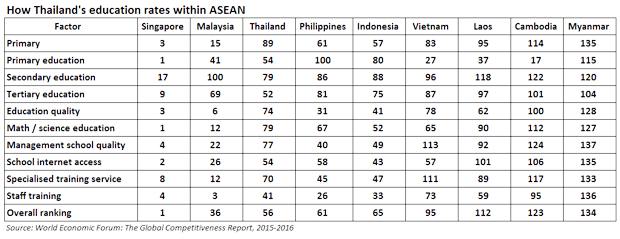Can Thailand’s vocational education meet employment needs?
- Published: Jun 13, 2016 11:39
- Writer: Christopher Bruton | 6,128 viewed
Employers, human resource specialists, bilateral and multilateral government agencies complain that Thailand’s vocational education fails to provide the training and skill sets to enable young workers to meet the needs of modern industry.

A recent report quotes Japanese Embassy and Japan International Cooperation Agency (JICA) sources, expressing concerns that the Thailand vocational education system is unable to prepare students to match the demands of Japanese industry. As Thailand’s largest investment source, Japan is committed to making Thailand a major centre for long-term industrial development. Educational standards need to be raised so that a skilled labour force can start working in real life industrial conditions immediately after graduation from vocational schools. According to JICA, barely 5 per cent of vocational graduates would meet minimum standards and readily gain employment.
The main reasons for this situation are identified as lack of qualified instructors, inadequate equipment and insufficient practical experience during training. Instructors themselves may have theoretical knowledge but have not been exposed to the realities of workplace situations.

So what is this vocational education that appears, in the view of employers, to be so deficient? At the end of lower secondary education students have the option of transferring into the vocational education stream. Of those students that proceed to the Upper Secondary level, government policy aims to have an equal proportion of students enter the vocational and general streams, thereby stressing the need to match educational output with occupational intake. However the actual proportion of entrants has tended to be 40 per cent into the vocational stream and 60 per cent into the general stream. This arises from the greater prestige of general education over vocational education, a situation which is common the world over. In Western parlance, the “white collar” always has pride of place over the “blue collar” and the same situation persists in Thailand too.
There are now 425 public schools with 675,000 students, and 461 private schools with 300,000 students, making a total of 886 schools with 975,000 students. Reform plans provide that proportionate vocational and general stream enrolments will steadily rise to 50/50 per cent, with fewer drop-outs from the educational system after Lower Secondary level. Drop-outs would be encouraged to opt for vocational studies to improve their chances of progressing to higher skilled employment. After completing the three-year vocational course, students may gain a Certificate in Vocational Education with two options: one with purely theoretical studies, and an alternative intended to combine theory with practical training within industry.
Students may proceed to tertiary vocational education. These studies were held in technical colleges, but, as in many countries, there has been a tendency to upgrade, if not in quality, then at least in name, with establishment of “Rajamangala Universities of Technology” nationwide.
In terms of ASEAN ranking, Thailand’s overall education rating is not particularly high and threatens competitiveness and potential for innovation. The World Economic Forum ranked Thailand at 56 out of 140 countries, although Thailand ranked 89 for primary education, 79 for secondary education, 79 for mathematics and science, and 74 for education quality. Certainly there is a long way to go. Thailand does invest heavily in education, but perhaps not in the right directions.
An indication of some achievable solutions to the vocational education shortcomings might be gained from Australia’s TAFE System (Technical and Further Education) which provides a vocational alternative to the more traditional academic stream. TAFE in the past also experienced many shortcomings, but serious evaluation and resulting reform has made the system a highly workable channel for young people to transition from school to workplace and, having entered the workforce, to continue their education up to high standards.
The foremost characteristic of TAFE is its partnership with industry. TAFE asks industry what is wanted, and aims to provide the required skills. Courses are developed in cooperation with industry, and teachers coordinate with industry people, who often come to provide practical courses within the TAFE system. There is a great deal of interaction between school and workplace, including practical internships. After graduation and entry into vocational occupations, there are continuing opportunities to upgrade skills and adopt a lifelong learning process.
There is no need, however, to look as far distant as Australia’s TAFE. With top-ranking world education attainment, Singapore is a clear role model, just down the road and within ASEAN. While concerned about present vocational education performance, Japan has also taken a positive view, offering to provide guidance to reach required grades. There is a willingness for the massive Japanese industrial sector in Thailand to work hand-in-hand to design the courses, guide the training and provide the essential practical internships. What is needed is a positive commitment on the part of the educational authorities to structure vocational education in accordance with industrial demands, and let industry help to provide it. With the current command economy, now appears the time to get moving, before industries themselves move elsewhere.
Christopher F. Bruton, 45 years in Thailand, is Executive Director of Dataconsult Ltd, a local consultancy. He can be reached at chris@dataconsult.co.th.


